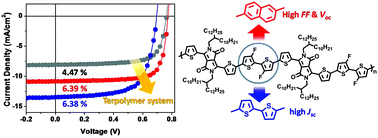Regular terpolymers with fluorinated bithiophene units for high-performing photovoltaic cells†
Abstract
We demonstrate effective structural control of various electron-donating moieties containing bithiophene (BT) and naphthalene derivatives with 3,3′-difluoro-2,2′-bithiophene in a regular terpolymer system and compare the properties of these polymers with those of the three binary copolymers PDPPNp, PDPPBT, and PDPPFBT. PDPPBF and PDPPNF were successfully synthesized to be diketopyrrolopyrrole (DPP)-based terpolymers. The optical and electronic properties of these regular terpolymers could be precisely controlled by introducing three different components in the repeating units. A polymer solar cell (PSC) made of PDPPNF, which contains naphthalene as a weak donating unit, had a high open-circuit voltage (Voc) of 0.77 V, resulting from a relatively deep HOMO energy level. In contrast, PDPPBF bearing BT, which is an example of a relatively strong electron-donating unit, had a higher short-circuit current density (Jsc = 13.44 mA cm−2) than that of PDPPFBT. Therefore, improved power conversion efficiency (PCE) was possible in a PSC made of PDPPBF containing the electron-donating bithiophene unit in the terpolymer backbone. However, the improved internal morphology, as characterized by AFM and TEM, was the primary contributor to the enhanced PCEs (i.e., 6.38% and 6.39% for PDPPBF and PDPPNF, respectively).


 Please wait while we load your content...
Please wait while we load your content...